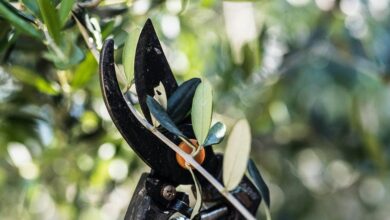Jupiter tree

Lagerstroemia indica is a species of the Lythraceae family, which has its origin in the Asian continent, the Philippines and Australia. It is commonly called the Jupiter tree and is considered an ornamental plant due to its abundant flowering. However, it needs certain care for proper development.
We can describe the Jupiter tree as a deciduous woody plant with a very bright and intense green color during the summer. Before the leaves fall in autumn, they turn reddish gold and purple colors. The trunk usually develops crooked and has a smooth, light brown surface. As for the flowers, they grow in clusters and can have different shades, the most common being white, red and pink.
The flowering stage of the so-called Indian tree begins when the summer is already well established and lasts until the beginning of autumn. Due to the beauty of its flowers, it is widely used to form hedges in the garden, thanks to the fact that it does not measure more than 8 meters, however, it is also ornamental as a solitary specimen to embellish the lawn.
In this sense, although it is a deciduous species, it has ornamental value throughout the year, even in winter, due to the attractive tone of its trunk. The life cycle of this pink-flowered tree can reach 120 years if it is planted in its habitat, with abundant sunlight and relatively moist soil. However, we must mention that it is a slow-growing tree, so you must be patient. On the other hand, the wood of Lagerstroemia indica is highly valued in cabinetmaking for being hard and of great quality.
History of the tree of Jupiter
Although the idea that the tree of Jupiter has a Chinese origin is currently widely accepted, the name Lagerstroemia was given in honor of the Swedish naturalist Magnus von Lagerstroem, who was a friend and compatriot of the botanist Linnaeus. As the story goes, Lagerstroem, who was originally from the city of Göteborg, discovered the bush in 1759 during his work as director of the Swedish East India Company. Lagerstroem himself was in charge of sending his friend Linnaeus a copy to Sweden on a long boat trip. Upon receiving it, the scientist decided to call it Lagerstroemia, after the surname of his friend and Indica after the place where the tree was collected.

How to plant a Jupiter tree?
Botanical experts recommend planting the Jupiter tree in autumn or spring, however, the process begins in summer, where a semi-woody branch should be cut, taking care to select one that does not have flowers and measures around 40 cm. Next, the base must be impregnated with a rooting solution to proceed with planting in a pot with abundant sandy-type substrate. Then, you have to place it in a place where it is exposed to direct sunlight. The rooting period lasts approximately 3 months, so it is recommended to first grow the Jupiter tree in a pot and when it is strong enough, transplant it into the ground.
Jupiter Tree Requirements
Although it can grow in semi-shade, the Lagerstroemia indica species prefers a sunny environment, so it is advisable to plant in full sun, as long as the soil is fertile, fresh and rich in organic matter. In limestone soil with a pH greater than 6.5, the leaves turn yellow due to iron deficiency. In addition, it is essential that the land has a good drainage system. In this sense, irrigation should be scarce in winter, but very abundant in summer, at least 3 times a week. During these hot months, it is good to apply mineral fertilizers with irrigation every 2 weeks.
Its original habitat is in temperate climates, however, the Jupiter tree is quite hardy, so it can adapt to cold weather conditions and withstand frost. As far as pruning is concerned, it is recommended to do it at the end of winter, with the aim of eliminating the branches with flowers from the previous year and promoting the new cycle. Thus, when spring arrives, the new flowering is stronger and the tree grows with greater vigor.

Diseases and pests that can attack Lagerstroemia indica
The Jupiter tree can present some problems related to a cryptogamic disease caused by ectoparasitic fungi, known as powdery mildew, which appears in the form of white ash on the leaves and stem. This is due to excess humidity, so it is worth insisting that the soil should not be too humid and the plant should receive direct sunlight.
The treatment to eradicate powdery mildew is based on fungicides, but the problem must be attacked immediately, since over time the plague can destroy the beauty and vitality of the tree.
Another pest that can invade the Jupiter tree is that of aphids. To prevent, you can spray white vinegar diluted in water, but if your plant has already been attacked, it is necessary to use a special pesticide for aphids, since these insects can wreak havoc on the leaves and stems.
It is good to take the corresponding precautions, not only after planting or transplanting in the ground, but also during the rooting period. If you need to clean the pot on the outside, you can use the best baby wipes, checking that they have low alcohol content for safety.
Components and properties of Lagerstroemia indica
Jupiter tree contains methyl gallate, gallic acid, fats, proteins and ellagic acid. In alternative medicine, the roots cooked in water have been used to treat stomach aches and thrush. For its part, the flowers and leaves can serve as a diuretic and purgative. However, we must say that there is not enough scientific evidence in this regard, so it is advisable to consult a professional before using this plant as a therapeutic complement.



